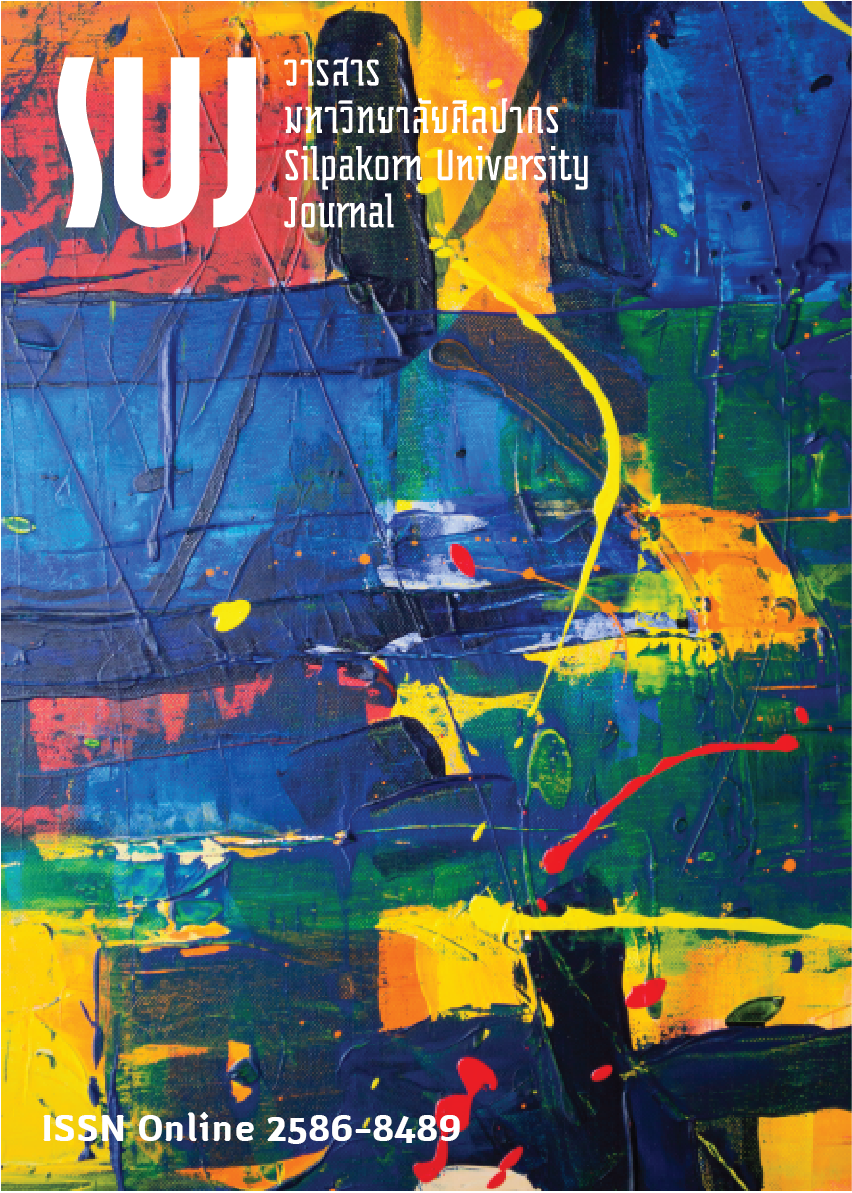การศึกษาความต้องการที่จำเป็นเพื่อการพัฒนารูปแบบความฉลาดทางการเคลื่อนไหวสำหรับเด็กปฐมวัย (A study of needs assessment for the development of preschool children’s physical literacy model)
Main Article Content
Abstract
การพัฒนาความฉลาดทางการเคลื่อนไหวสำหรับเด็กปฐมวัยมีความสำคัญเนื่องจากสามารถช่วยส่งเสริมให้เด็กมีความสามารถในการรับรู้ มีความเข้าใจในวัตถุประสงค์ เนื้อหาและทักษะการเคลื่อนไหวที่ถูกต้อง รวมทั้งมีสมรรถภาพทางกายดีขึ้น ซึ่งองค์ประกอบเหล่านี้จะส่งผลให้เด็กเกิดการพัฒนาได้เต็มตามศักยภาพ ทั้งด้านร่างกาย ด้านจิตใจ ด้านอารมณ์และด้านสังคม ในการทำการวิจัยเรื่องการพัฒนารูปแบบความฉลาดทางการเคลื่อนไหวสำหรับเด็กปฐมวัย จึงจำเป็นต้องศึกษาความต้องการที่จำเป็น (needs assessment) เพื่อให้ได้ข้อมูลเบื้องต้นก่อนการวางแผนการดำเนินการวิจัยในลำดับขั้นต่อ ๆ ไป โดยผู้วิจัยได้สัมภาษณ์ครูผู้สอนระดับชั้นปฐมวัย (อนุบาล 3) จำนวน 15 คน จาก 12 โรงเรียน ในสังกัดสำนักงานเขตพื้นที่การศึกษาประถมศึกษากาญจนบุรี เขต 1-4 ซึ่งได้มาด้วยการสุ่มแบบหลายขั้นตอน (multi stages sampling) การเก็บข้อมูลความต้องการที่จำเป็นเพื่อการดำเนินการวิจัยครั้งนี้ ผู้วิจัยใช้การสัมภาษณ์แบบมีโครงสร้างประกอบการบันทึกเสียงการสัมภาษณ์และการจดบันทึก ผลการศึกษาพบว่า ครูผู้สอนระดับชั้นปฐมวัย (อนุบาล 3) แสดงถึงความต้องการที่จำเป็นของการมีรูปแบบความฉลาดทางการเคลื่อนไหวสำหรับเด็กปฐมวัยด้านเนื้อหา ( = 2.84) และด้านการจัดกิจกรรมการพัฒนาความฉลาดทางการเคลื่อนไหว (
= 2.82) อยู่ในระดับมาก ด้านการจัดกิจกรรมการเคลื่อนไหว (
= 2.79) อยู่ในระดับปานกลาง ด้านการบริหารจัดการหลักสูตรการศึกษาปฐมวัย (
= 2.77) และด้านการประเมินผล (
= 2.77) อยู่ในระดับน้อย
The development of preschool children’s physical literacy model is important for preschool children because it can enhance their perception and understanding of objectives, contents, proper basic movement, and higher physical fitness levels.Therefore, all elements would affect children’s potential in the aspects of physical, mental, emotional and social development, so needs assessment is important for the research entitled “A Study of Needs Assessment for the Development of Preschool Children’s Physical Literacy Model” to collect fundamental information for further research planning.The researcher interviewed 15 teachers who teach at 12 kindergartens under the Kanchanaburi Primary Education Service Area Office 1-4, which were randomized by multi-stages random sampling. In collecting data, the researcher interviewed teachers with structured interview, recording, and note-taking method as well. Then, it was found that the kindergarten teachers felt the need for the physical movement literacy patterns model for preschool children in the aspect of contents ( = 2.84) and activities to develop movement physical literacy (
= 2.82) at a high level. The activities of movement was at a medium level (
= 2.79). The management of early childhood education curriculum (
= 2.77), and the evaluation (
= 2.77) were at a low level.
Downloads
Article Details

This work is licensed under a Creative Commons Attribution-NonCommercial-NoDerivatives 4.0 International License.
References
Bandit, Supaporn. (2013). The Developmental Psychology Theory Related to Early Childhood (ทฤษฎีจิตวิทยาพัฒนาการที่เกี่ยวข้องกับเด็กปฐมวัย). [Online]. Retrieved June 27, 2018 from http://elearning.psru.ac.th/courses/77/unit5.pdf
Detkup, Yaowapa. (1997). CE 335 Music and Rhythemic Activities for Preschools (ดนตรีและกิจกรรมเข้าจังหวะสำหรับเด็กปฐมวัย เอกสารคำสอนวิชา ปว 335). Bangkok: Department of Curriculum and Instruction, Faculty of Education, Srinakharinwirot University.
Edwards, C. L. (2006). The Creative Arts: A Process Approach for Teacher and Children. New Jersey: Pearson education.
England, P. (2006). Planning for Play. London: National Children’s Bureau.
Goonchamorin, Kwanchanok. (2014). A Study of Problems and Guidelines on Development of Child Development Centers Administration in the Sahatsakhan District Area, Kalasin Province (การศึกษาปัญหาและแนวทางการพัฒนาการบริหารจัดการศูนย์พัฒนาเด็กเล็กในเขตอำเภอสหัสขันธ์ จังหวัดกาฬสินธุ์). Nakhon Phanom University Journal, 4(1): 81-88.
Jatisathian, Chaniphan, et al. (2017). Holistic Early Childhood Development, Early Childhood Crisis and Solutions (การพัฒนาเด็กปฐมวัยอย่างเป็นองค์รวมวิกฤตปฐมวัยและแนวทางแก้ไข). Bangkok: Plus Press Company Limited.
Kanchanawassi, Sirichai. (2001). Choosing the Right Statistics for Research (การเลือกใช้สถิติที่เหมาะสมสำหรับการวิจัย) (4th ed.). Bangkok: Boonsiri Printing.
Krabuanrat, Charoen. (2009). 9 Square Table with Brain Development (ตาราง 9 ช่องกับการพัฒนาสมอง). Bangkok: The Sintana Copy Center Limited.
Khamani, Tassana. (1992). Development Principles and Patterns of Young Children Along the Thai Way of life (หลักการและรูปแบบการพัฒนาเด็กปฐมวัยตามวิถีไทย). Bangkok: Chulalongkorn University.
Kulapichitr, Udomluck. (2010). The Development of Instructional Model for Kindergarteners (การพัฒนารูปแบบการเรียนการสอนสำหรับเด็กอนุบาล). Bangkok: Faculty of Education, Chulalongkorn University.
Kuna-Apisit, Wasana. (2016). The Development of Physical Activity Curriculum for Student in Thailand (การพัฒนาหลักสูตรกิจกรรมทางกายสำหรับนักเรียนในประเทศไทย). Journal of Health, Physical Education and Recreation, 42(2): 44-85.
Limwattanasamut, Chaweewan. (2010). State and Problems of Early Childhood Education Administration in Schools Under the Offices of Nakhon Phanom Educational Service Area (สภาพและปัญหาการดำเนินงานจัดการศึกษาระดับปฐมวัยในโรงเรียน สังกัดสำนักงานเขตพื้นที่การศึกษาในจังหวัดนครพนม). Rajabhat Sakon Nakhon University Journal, 2(4): 134-150.
Ministry of Education. (2010). National Education Act B.E. 2553 (2010) (พระราชบัญญัติการศึกษาแห่งชาติ พุทธศักราช 2553 (ฉบับที่ 3). Bangkok: Siam Sport Syndicate Company Limited.
Ministry of Education. (2017). 2017 Early Childhood Education Curriculum (หลักสูตรการศึกษาปฐมวัย พุทธศักราช 2560). Bangkok: The Agricultural Cooperative Federation of Thailand Limited.
National Education Act B.E. 2562. (2019). [Online]. Retrieved September 25, 2019 from http://www.ratchakitcha.soc.go.th/DATA/PDF/2562/A/057/T_0049.pdf
Office of the National Economic and Economic Development Board, Prime Minister’s Office. (2016). National Economic and Social Development Plan Twelfth edition B.E. 2560-2021 (แผนพัฒนาเศรษฐกิจและสังคมแห่งชาติ ฉบับที่สิบสอง พ.ศ. 2560-2564). [Online]. Retrieved September 25, 2019 from http://www.royalthaipolice.go.th/downloads/ plan12.pdf
Quality Learning Foundation. (2014). Open the Situation of Early Childhood the Phenomenon of Accelerating Learning from Kindergarten (เปิดสถานการณ์เด็กปฐมวัยพบปรากฏการณ์เร่งเรียนตั้งแต่วัยอนุบาล). [Online]. Retrieved September 25, 2019 from http://qlf.or.th/Home/Contents/1009
Suwankan, Suriyan. (2017). Use of Physical Activity to Develop Physical Literacy for Prathomsuksa 3 Students (การใช้กิจกรรมทางกายเพื่อพัฒนาความสามารถในการเรียนรู้ทางกายสำหรับนักเรียนประถมศึกษาปีที่ 3). Doctoral dissertation, Kasetsart University, Bangkok, Thailand.
Seefeldt, V. (1993). Developmental Motor Patterns. In R. Nadau, C. W. Holliwell and K. G. Newell, (Eds.), Psychology of Motor Behaviour in Sport. Champaing, Ill: Human Kinetics.
Thepthien, Bangon, & Trakulwong, Piyachat. (2007). Early childhood care in Thailand (การดูแลเด็กปฐมวัยของประเทศไทย). Journal of Public Health and Development, 5(3): 167-176.
The Secretariat of the Council of Education, Ministry of Education. (2007). Policies and Strategiesfor Early Childhood Development (0-5 years), Long Term 2007-2016 (นโยบายและยุทธศาสตร์การพัฒนาเด็กปฐมวัย (0-5 ปี) ระยะยาว พ.ศ. 2550-2559). Bangkok: VTC Communication Limited Partnership.
The Secretariat of the Council of Education, Ministry of Education. (2009). Performance of Early Childhood Development According to Age 3-5 Years: Guidelines for Caregivers Teachers and Professors (สมรรถนะของเด็กปฐมวัยในการพัฒนาตามวัย 3-5 ปี: แนวแนะสำหรับผู้ดูแลเด็ก ครูและอาจารย์). Bangkok: Plan for Kids Company Limited.
Thomas, J. W. (2011). Creativity through music and movement. Illinois Music Educator, 72: 98-99.
Whitehead, M. (2011). Physical Literacy: Throughout the Lifecourse. International Studies in Physical Education and Young Sport.


